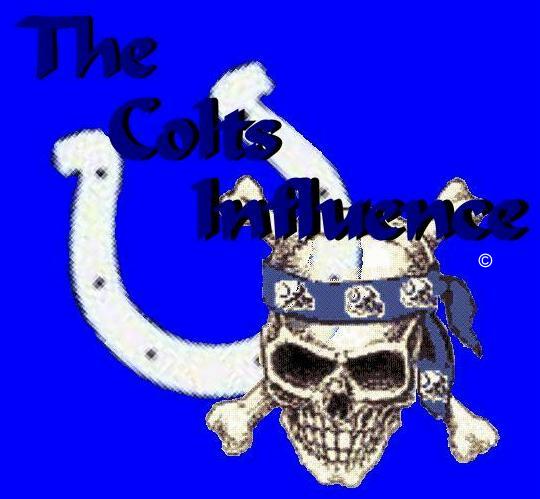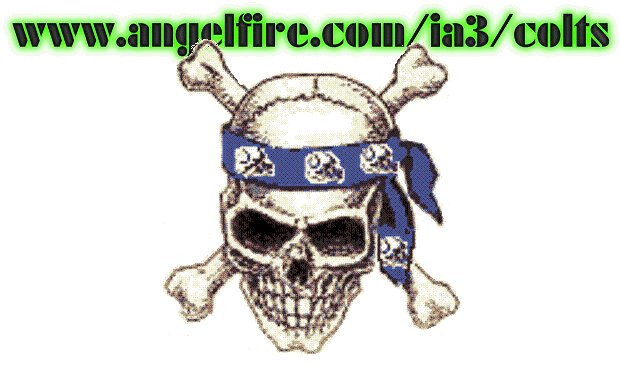|
The Colts Influence
Constructed, destructed and reconstructed
Colts
FORUM
Colts
BLOG
The Colts Influence www.mycolts.net/coltsinfluence http://myspace.com/coltsinfluence
|
Players-Substitutions
Kickoff
Safety
Fair catch kick
Field Goal
Safety
Measuring
Position
of players at snap
Use Of Hands,
Arms and Body
1. Each team is permitted 11 men on the field at the snap. 2. Unlimited substitution is permitted. However, players may enter the field only when the ball is dead. Players who have been substituted for are not permitted to linger on the field. Such lingering will be interpreted as unsportsmanlike conduct. 3. 12 men delayed in huddle-illegal substitution. 4. Players leaving the game must be out of bounds on their own side, clearing the field between the end lines, before a snap or free kick. If player crosses end line leaving field, it is delay of game (five-yard penalty). 5. Substitutes who remain in the game must move onto the field as far as the inside of the field numerals before moving to a wide position.
6. With the exception of the last two minutes of
either half, the offensive team, while in the process of substitution
or simulated substitution, is prohibited from rushing quickly to the
line and snapping the ball with the obvious attempt to cause a
defensive foul;
Descriptions of kickoff regulations 1. The kickoff shall be from the kicking team's 30-yard line at the start of each half and after a field goal and try-for-point. A kickoff is one type of free kick. 2. A one-inch tee may be used (no tee permitted for field goal or try attempt) on a kickoff. The ball is put in play by a placekick or dropkick. 3. If the kickoff clears the opponent's goal posts it is not a field goal.
4. A kickoff is illegal unless it travels 10 yards OR
is touched by the receiving team. Once the ball is touched by the
receiving team it is a free ball. Receivers may recover and advance. 5. When a kickoff goes out of bounds between the goal lines without being touched by the receiving team, the ball belongs to the receivers 30 yards from the spot of the kick or at the out-of-bounds spot unless the ball went out-of-bounds the first time an onside kick was attempted. In this case the kicking team is to be penalized five yards and the ball must be kicked again. 6. When a kickoff goes out of bounds between the goal lines and is touched last by receiving team, it is receiver's ball at out-of-bounds spot.
1. After a fair catch, the receiving team has the
option to put the ball in play by a snap or a fair catch kick
(field goal attempt), with fair catch kick
lines established ten yards apart. All general rules apply as for a
field goal attempt from scrimmage.
1. All field goals attempted (kicker) and missed from beyond the 20-yard line will result in the defensive team taking possession of the ball at the spot of the kick. On any field goal attempted and missed where the spot of the kick is on or inside the 20-yard line, ball will revert to defensive team at the 20-yard line.
Safety 1. In addition to a kickoff, the other free kick is a kick after a safety (safety kick). A punt may be used (a punt may not be used on a kickoff).
2. On a safety kick, the team scored upon puts ball in
play by a punt, dropkick, or placekick without tee. No score can be
made on a free kick following a safety, even if a series of penalties
places team in position.
Safety 1. The important factor in a safety is impetus. Two points are scored for the opposing team when the ball is dead on or behind a team's own goal line if the impetus came from a player on that team. Examples of Safety:
Examples of Non-Safety:
1. The forward point of the ball is used when measuring.
1. Offensive team must have at least seven players on line.
2. Offensive players, not on line, must be at least
one yard back at snap. 3. No interior lineman may move after taking or simulating a three-point stance. 4. No player of either team may invade neutral zone before snap. 5. No player of offensive team may charge or move, after assuming set position, in such manner as to lead defense to believe snap has started. No player of the defensive team within one yard of the line of scrimmage may make an abrupt movement in an attempt to cause the offense to false start. 6. If a player changes his eligibility, the Referee must alert the defensive captain after player has reported to him. 7. All players of offensive team must be stationary at snap, except one back who may be in motion parallel to scrimmage line or backward (not forward). 8. After a shift or huddle all players on offensive team must come to an absolute stop for at least one second with no movement of hands, feet, head, or swaying of body. 9. Quarterbacks can be called for a false start penalty (five yards) if their actions are judged to be an obvious attempt to draw an opponent offside.
1. No player on offense may assist a runner except by blocking for him. There shall be no interlocking interference. 2. A runner may ward off opponents with his hands and arms but no other player on offense may use hands or arms to obstruct an opponent by grasping with hands, pushing, or encircling any part of his body during a block. Hands (open or closed) can be thrust forward to initially contact an opponent on or outside the opponent's frame, but the blocker must work to bring his hands on or inside the frame.
Note:
Pass blocking: Hand(s) thrust forward that slip outside the
body of the defender will be legal if blocker worked to bring them
back inside. Hand(s) or arm(s) that encircle a defender - Blocker cannot use his hands or arms to push from behind, hang onto, or encircle an opponent in a manner that restricts his movement as the play develops. 3. Hands cannot be thrust forward above the frame to contact an opponent on the neck, face or head. Note: The frame is defined as the part of the opponent's body below the neck that is presented to the blocker. 4. A defensive player may not tackle or hold an opponent other than a runner. Otherwise, he may use his hands, arms, or body only:
5. A defensive player may not contact an opponent above the shoulders with the palm of his hand except to ward him off on the line. This exception is permitted only if it is not a repeated act against the same opponent during any one contact. In all other cases the palms may be used on head, neck, or face only to ward off or push an opponent in legal attempt to get at the ball. 6. Any offensive player who pretends to possess the ball or to whom a teammate pretends to give the ball may be tackled provided he is crossing his scrimmage line between the ends of a normal tight offensive line. 7. An offensive player who lines up more than two yards outside his own tackle or a player who, at the snap, is in a backfield position and subsequently takes a position more than two yards outside a tackle may not clip an opponent anywhere nor may he contact an opponent below the waist if the blocker is moving toward the ball and if contact is made within an area five yards on either side of the line. 8. A player of either team may block at any time provided it is not pass interference, fair catch interference, or unnecessary roughness. 9. A player may not bat or punch:
Note: If there is any question as to whether a defender is stripping or batting a ball in player possession, the official(s) will rule the action as a legal act (stripping the ball). Exception : A forward or backward pass may be batted, tipped, or deflected in any direction at any time by either the offense or the defense. Note: A pass in flight that is controlled or caught may only be thrown backward; if it is thrown forward it is considered an illegal bat. 10. No player may deliberately kick any ball except as a punt, dropkick, or placekick.
This website is an unofficial source of news and information continually updated from thousands of sources around the net. A fan based site dedicated to the Indianapolis Colts and its fans and is not associated with the Indianapolis Colts, the National Football League, any school, team or league or any other media site. This website is the composition of many hours of research. Information contained within this site has come from numerous sources such as websites, newspapers, books, and magazines. Please take the time to visit the Source page to get a semi-complete listing of these sources, articles, sites and fans.
Pictures and logos, team names are property of
the National Football League and/or The Indianpolis Colts.
Please direct website comments
|
|||||||||||||||||||||




